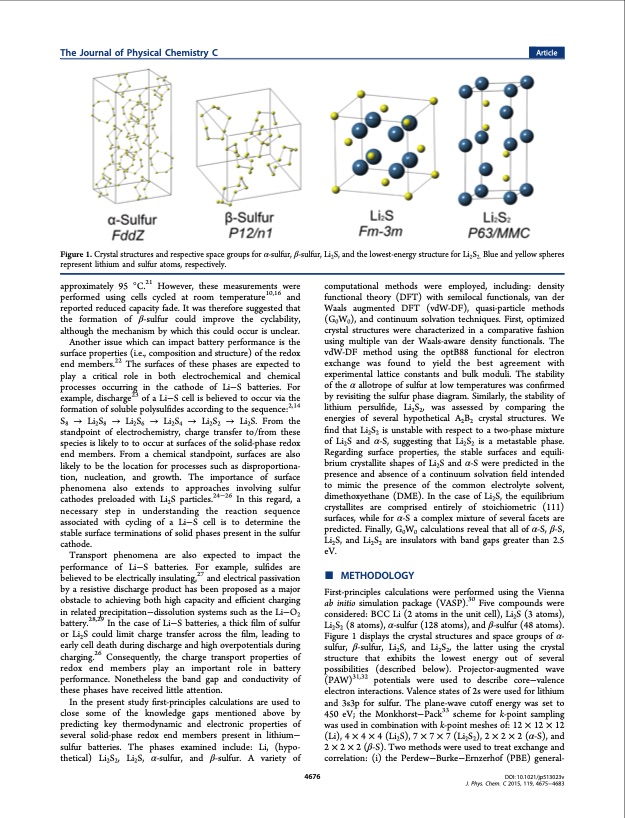
PDF Publication Title:
Text from PDF Page: 002
The Journal of Physical Chemistry C Article Figure 1. Crystal structures and respective space groups for α-sulfur, β-sulfur, Li2S, and the lowest-energy structure for Li2S2. Blue and yellow spheres represent lithium and sulfur atoms, respectively. approximately 95 °C.21 However, these measurements were performed using cells cycled at room temperature10,16 and reported reduced capacity fade. It was therefore suggested that the formation of β-sulfur could improve the cyclability, although the mechanism by which this could occur is unclear. Another issue which can impact battery performance is the surface properties (i.e., composition and structure) of the redox end members.22 The surfaces of these phases are expected to play a critical role in both electrochemical and chemical processes occurring in the cathode of Li−S batteries. For example, discharge23 of a Li−S cell is believed to occur via the formation of soluble polysulfides according to the sequence:2,14 S8 → Li2S8 → Li2S6 → Li2S4 → Li2S2 → Li2S. From the standpoint of electrochemistry, charge transfer to/from these species is likely to to occur at surfaces of the solid-phase redox end members. From a chemical standpoint, surfaces are also likely to be the location for processes such as disproportiona- tion, nucleation, and growth. The importance of surface phenomena also extends to approaches involving sulfur cathodes preloaded with Li2S particles.24−26 In this regard, a necessary step in understanding the reaction sequence associated with cycling of a Li−S cell is to determine the stable surface terminations of solid phases present in the sulfur cathode. Transport phenomena are also expected to impact the performance of Li−S batteries. For example, sulfides are believed to be electrically insulating,27 and electrical passivation by a resistive discharge product has been proposed as a major obstacle to achieving both high capacity and efficient charging in related precipitation−dissolution systems such as the Li−O2 battery.28,29 In the case of Li−S batteries, a thick film of sulfur or Li2S could limit charge transfer across the film, leading to early cell death during discharge and high overpotentials during charging.26 Consequently, the charge transport properties of redox end members play an important role in battery performance. Nonetheless the band gap and conductivity of these phases have received little attention. In the present study first-principles calculations are used to close some of the knowledge gaps mentioned above by predicting key thermodynamic and electronic properties of several solid-phase redox end members present in lithium− sulfur batteries. The phases examined include: Li, (hypo- thetical) Li2S2, Li2S, α-sulfur, and β-sulfur. A variety of 4676 computational methods were employed, including: density functional theory (DFT) with semilocal functionals, van der Waals augmented DFT (vdW-DF), quasi-particle methods (G0W0), and continuum solvation techniques. First, optimized crystal structures were characterized in a comparative fashion using multiple van der Waals-aware density functionals. The vdW-DF method using the optB88 functional for electron exchange was found to yield the best agreement with experimental lattice constants and bulk moduli. The stability of the α allotrope of sulfur at low temperatures was confirmed by revisiting the sulfur phase diagram. Similarly, the stability of lithium persulfide, Li2S2, was assessed by comparing the energies of several hypothetical A2B2 crystal structures. We find that Li2S2 is unstable with respect to a two-phase mixture of Li2S and α-S, suggesting that Li2S2 is a metastable phase. Regarding surface properties, the stable surfaces and equili- brium crystallite shapes of Li2S and α-S were predicted in the presence and absence of a continuum solvation field intended to mimic the presence of the common electrolyte solvent, dimethoxyethane (DME). In the case of Li2S, the equilibrium crystallites are comprised entirely of stoichiometric (111) surfaces, while for α-S a complex mixture of several facets are predicted. Finally, G0W0 calculations reveal that all of α-S, β-S, Li2S, and Li2S2 are insulators with band gaps greater than 2.5 eV. ■ METHODOLOGY First-principles calculations were performed using the Vienna ab initio simulation package (VASP).30 Five compounds were considered: BCC Li (2 atoms in the unit cell), Li2S (3 atoms), Li2S2 (8 atoms), α-sulfur (128 atoms), and β-sulfur (48 atoms). Figure 1 displays the crystal structures and space groups of α- sulfur, β-sulfur, Li2S, and Li2S2, the latter using the crystal structure that exhibits the lowest energy out of several possibilities (described below). Projector-augmented wave (PAW)31,32 potentials were used to describe core−valence electron interactions. Valence states of 2s were used for lithium and 3s3p for sulfur. The plane-wave cutoff energy was set to 450 eV; the Monkhorst−Pack33 scheme for k-point sampling was used in combination with k-point meshes of: 12 × 12 × 12 (Li),4×4×4(Li2S),7×7×7(Li2S2),2×2×2(α-S),and 2 × 2 × 2 (β-S). Two methods were used to treat exchange and correlation: (i) the Perdew−Burke−Ernzerhof (PBE) general- DOI: 10.1021/jp513023v J. Phys. Chem. C 2015, 119, 4675−4683PDF Image | First-Principles Study of Redox End Members in Lithium Sulfur

PDF Search Title:
First-Principles Study of Redox End Members in Lithium SulfurOriginal File Name Searched:
JPCC_Li-S.pdfDIY PDF Search: Google It | Yahoo | Bing
Sulfur Deposition on Carbon Nanofibers using Supercritical CO2 Sulfur Deposition on Carbon Nanofibers using Supercritical CO2. Gamma sulfur also known as mother of pearl sulfur and nacreous sulfur... More Info
CO2 Organic Rankine Cycle Experimenter Platform The supercritical CO2 phase change system is both a heat pump and organic rankine cycle which can be used for those purposes and as a supercritical extractor for advanced subcritical and supercritical extraction technology. Uses include producing nanoparticles, precious metal CO2 extraction, lithium battery recycling, and other applications... More Info
| CONTACT TEL: 608-238-6001 Email: greg@infinityturbine.com | RSS | AMP |